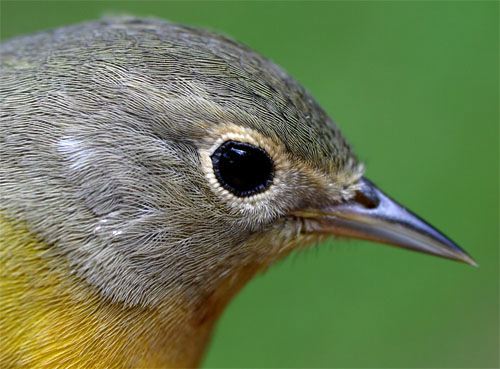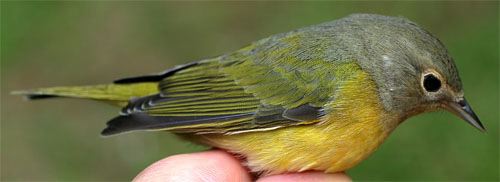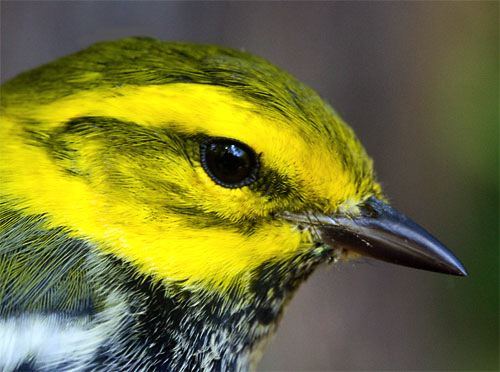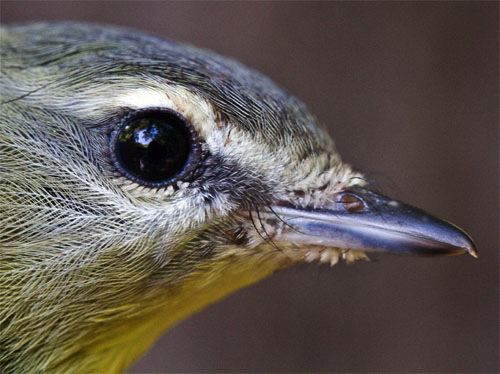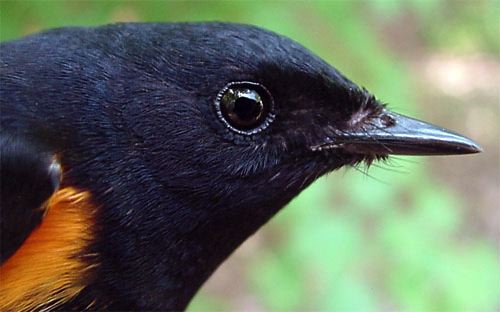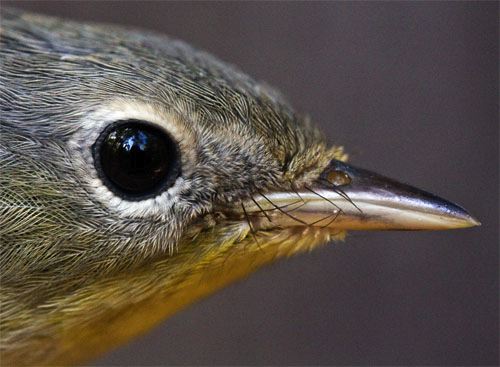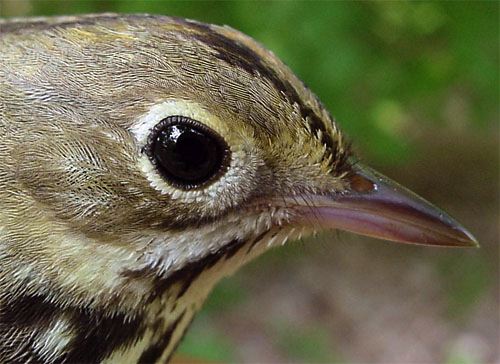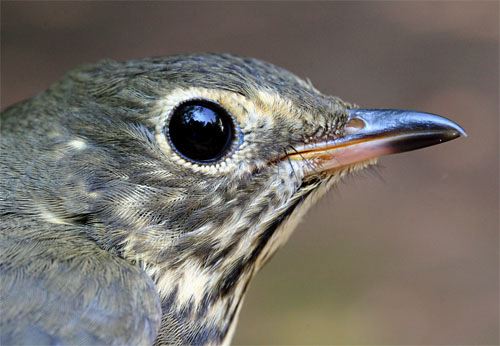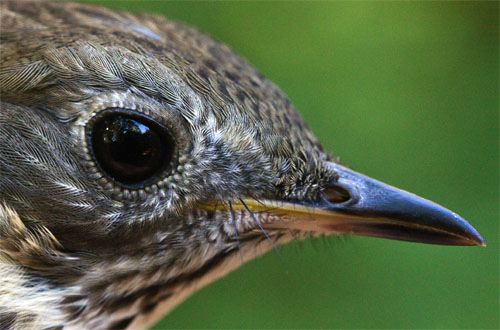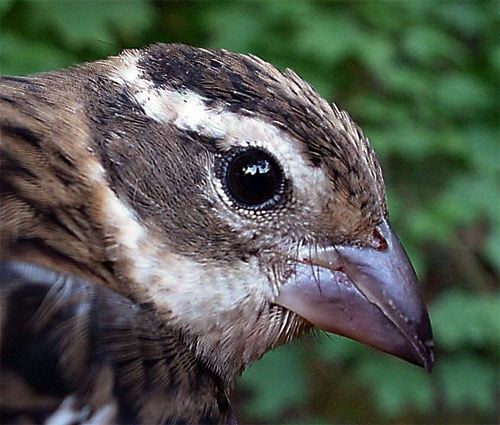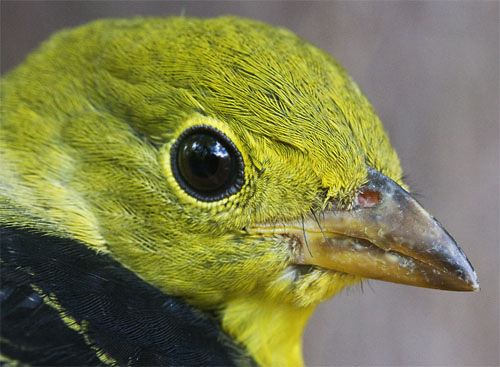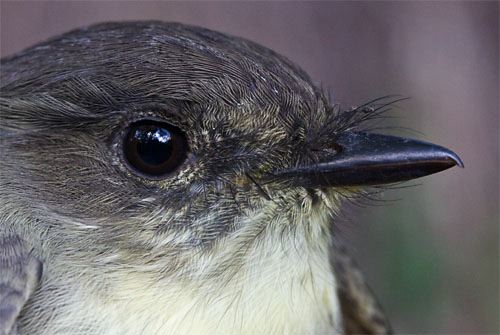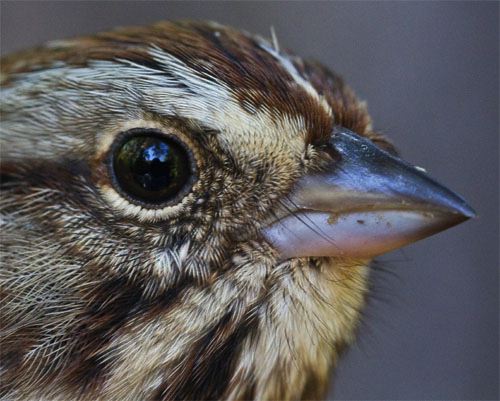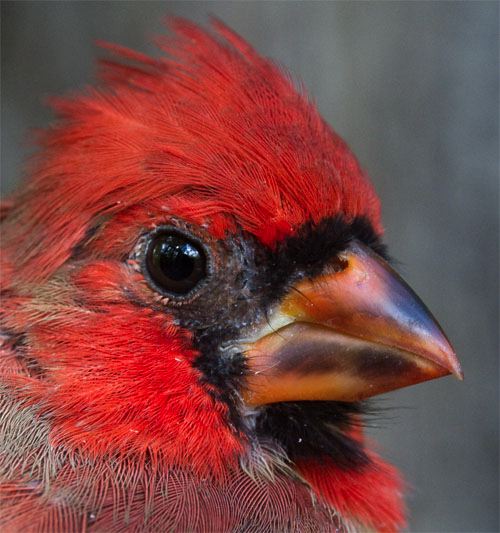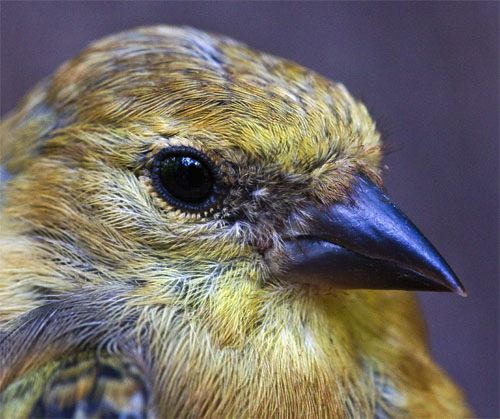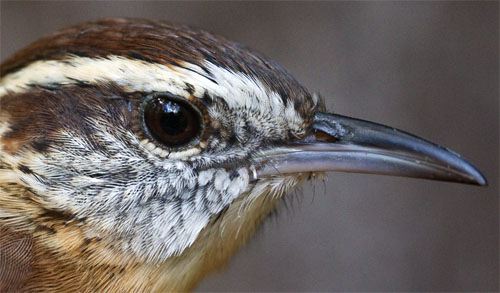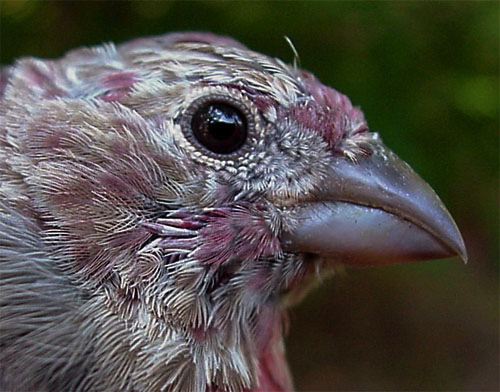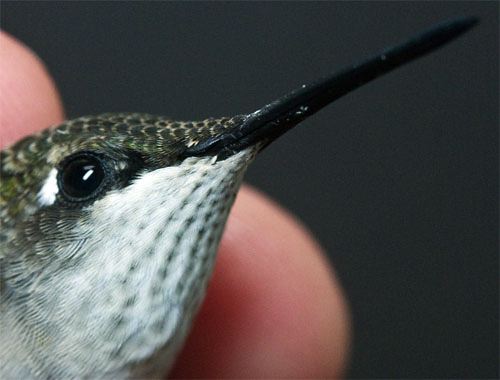|
|
|||
|
(Back to Preceding Week; on to Next Week) |
|
All text & photos © Hilton Pond Center BIRDS OF AUTUMN Back in early September the season's first noticeable bird migration began, and on 10 September we caught a rarity for Hilton Pond Center: An immature Nashville Warbler (above and below). During almost three decades of banding here at the Center we've captured only eight Nashvilles, so we mentioned in that week's miscellaneous notes that this particular individual was in the running for our "Best Banded Bird of the Year." This week, however, the Nashville Warbler got some competition--as described below in our latest photo essay about "Birds of Autumn."
All text & photos © Hilton Pond Center We were indeed pleased with our capture of Hilton Pond's eighth Nashville Warbler, a bird we find attractive but not as showy as many of the parulids. Thus, if we were to base our "Best Banded Bird of the Year" on a combination of scarcity AND appearance, the award might go to another Wood Warbler that crossed our banding table this week: Black-throated Green Warbler.
All text & photos © Hilton Pond Center We were a bit surprised on 3 October when an adult male Black-throated Green Warbler (above and below) flew by--if only because we were standing two feet away when it hit one of our mist nets. We quickly removed this brightly colored individual, banded it, and sent it on its way toward the Neotropics.
All text & photos © Hilton Pond Center Even more surprisingly, we caught ANOTHER Black-throated Green Warbler two days later about ten feet from where we encountered the first one. Only once before--in 2008--have we banded two of this species (alpha code: BTNW) in one calendar year. In fact, in 28 years of research at Hilton Pond Center, we've banded only 12 BTNW. This, we thought, should make Black-throated Green Warbler a viable competitor with last month's Nashville Warbler for "Best Banded Bird of the Year." But that was before an even more unexpected bird showed up later this week.
All text & photos © Hilton Pond Center Shortly after lunch on 6 October we made a regular net check and returned to our computer desk to work. A few minutes later we looked up and gazed out the window--something we're prone to do a hundred times a day for inspiration--and noticed something in one of the mist nets. Lately our nets have been catching lots of falling leaves--the bane of autumn bird banders--but to be sure we went back out for a closer look. Sure enough, the object was wiggling, so we wisely concluded it wasn't a leaf. We could see its back and thought "Red-eyed Vireo," but when we went to the other side of the net to remove the bird we could see its yellow throat and underparts (above). As we removed it from the mesh it snapped and squeaked and bit just like a Red-eyed Vireo (note the hook on the end of the bill, above), but from its smaller size, dark eye, and yellow coloration we knew it was something far less common: Philadelphia Vireo!
All text & photos © Hilton Pond Center A Philadelphia Vireo is genuine cause for excitement at Hilton Pond Center. Our first local look at this species was 'way back in the 1980s with friend and student Russell Rogers, and we couldn't remember seeing one since. As we extracted the Philadelphia Vireo from the net we weren't sure we'd even actually banded the species locally, but it turns out we had; our tally sheets show we captured one and only one, in the autumn of 1994. Thus, this week's Philadelphia Vireo was only the second we've handled locally, putting it ahead of both Nashville Warbler and Black-throated green Warbler for "Best Banded Bird of the Year." Unless something exceedingly unusual shows up in one of our nets or traps between now and 11:59 p.m. on 31 December, this Philadelphia Vireo is now the front-runner. Yes, the Philadelphia Vireo and two Black-throated Green Warblers WERE rare birds for Hilton Pond Center, but this week we banded a total of 18 species, some much more common than others. Knowing we wanted to devote the current photo essay to fall migration, we took photos of almost every bird we handled. Without further ado, below we offer our gallery of avian mug shots to share with you our bander's-eye-view of "Birds of Autumn--Migratory and Otherwise." Birds of Autumn Portfolio
All text & photos © Hilton Pond Center Counting the Black-throated Green Warblers, we caught five parulid species this week at Hilton Pond Center, none of which was quite as colorful as the BTNW. One was a female Black-throated Blue Warbler (above), so different in appearance from her mate that John James Audubon originally thought the two were separate species. Through our 28 years of banding at the Center we've handled this species equally often in both northbound and southbound migration, with 88 banded in spring and 78 in fall.
All text & photos © Hilton Pond Center And speaking of differences in appearance--the adult male American Redstart (above) with his jet black body and orange flanks and tail spots looks very different from the female's plumage of olive green and pale yellow. Young males resemble females. Redstarts are among our most common warblers with 409 banded at Hilton Pond Center since 1982, all during migration. The species breeds rarely in the South Carolina Upstate.
All text & photos © Hilton Pond Center One of our most common parulids is the Magnolia Warbler (immature female, above), whose flashy white tail bar is a giveaway field mark. When you see only the head you should look for the yellow throat, a vague pale gray necklace, and a complete white eye ring. We've banded 410 Magnolia Warblers at the Center.
All text & photos © Hilton Pond Center The Ovenbird (above) is one of those brown, sexually monomorphic parulids that nest and forage on or close to the ground. Look for the huge pale eye ring and two head stripes between which lies a chestnut streak. At the Center we've banded 217 Ovenbirds; all have been encountered during spring or fall migration, even though the species is known to breed in neighboring counties. Ovenbirds look a lot more like thrushes than Wood Warblers.
All text & photos © Hilton Pond Center We did capture two species of thrushes this week, including the Swainson's Thrush (above). Although the spot-breasted thrushes are similar in appearance, with attention to detail all can be differentiated in the field. The Swainson's, of which we've banded 477 around Hilton Pond, has a buffy face and well-defined eye ring. For this migratory species, 90% of our encounters are in autumn.
All text & photos © Hilton Pond Center A little more difficult to identify is the Gray-cheeked Thrush (above), whose facial patterns and colors vary greatly among individuals. All gray-cheeks lack a buffy eye ring, however, separating them from Swainson's. This species is much less common at the Center, with only 99 banded since 1982.
All text & photos © Hilton Pond Center Another brown-backed bird that passes through Hilton Pond Center in spring and fall is the immature male Rose-breasted Grosbeak (above). Females resemble young males but have heavy brown breast streaks; the adult male with his rosy chest and black dorsum is unmistakable. Although we've caught a few of these big-billed birds in our mist nets, most of the 45 we've banded were captured in traps baited with black sunflower seeds--undoubtedly one of the grosbeak's favorite foods.
All text & photos © Hilton Pond Center Of our two tanager species, only Summer Tanager is encountered all summer, with 181 banded May through October at Hilton Pond Center. Although there are Piedmont nesting records for the less common Scarlet Tanager, we see them only during spring (23 banded) and fall (75). The immature male Scarlet Tanager above already has the jet black wings of the adult--yellow edgings indicate these feathers are newly acquired--but it may take him up to two years to convert his yellow body plumage to the brilliant scarlet that gives the species its name.
All text & photos © Hilton Pond Center We have Eastern Phoebes year-round at Hilton Pond Center--every year they nest on one of the columns on the front porch of our old farmhouse--but their numbers always increase significantly in autumn. We're not sure if this is because new birds are migrating from further north or if it's just a "fall shuffle" with phoebes from nearby locales dispersing onto the property. In any case, Eastern Phoebes are our most common local flycatcher with 267 banded in 28 years.
All text & photos © Hilton Pond Center Song Sparrows (above) also present an interesting question: They sing and breed just west and east of us, but we almost never see this species during summer at Hilton Pond Center--making it unclear whether they're nearby breeders, dispersers, or true migrants. One showed up this week and we'll probably capture a few more through the fall, with another big influx come next spring. Since 1982 we've banded 390 Song Sparrows, just 32% of them in autumn.
All text & photos © Hilton Pond CenterAlthough A species that shows one of the biggest influxes in fall is the Northern Cardinal, and because they come so early--beginning in August--we suspect they are not migrant birds from far away. As might be expected, the vast majority of cardinals that appear are young birds such as the male above, distinguishable as an immature by his still-dark bill color, poorly developed crest, and mix of red and brown body feathers.
All text & photos © Hilton Pond Center Female Northern Cardinals also appear in good numbers in autumn at Hilton Pond Center. The female above does have a complete crest and a bill that is fully orange, but examination of her overall plumage indicated she, too, was a young bird of the year. Northern Cardinals are our fifth most common species at the Center, with 2,288 banded since 1982.
All text & photos © Hilton Pond Center Back in the "old days" we almost never saw American Goldfinches except in winter at Hilton Pond Center, but over the past decade we've been banding more and more of them in midsummer--a sure sign they're breeding locally. Most of our 7,817 captures likely have been migrant birds from elsewhere, as indicated by individuals encountered at three locations in New York and one in Rumford, Maine; we also caught one female goldfinch that had been banded a year previously in Dunnville, Ontario. The immature male (above) caught this week undoubtedly came from a nest closer to Hilton Pond. He won't get an orange bill or his bright yellow breeding plumage until next spring.
All text & photos © Hilton Pond Center South Carolina's state bird--the long-billed Carolina Wren (above)--is a year-round resident at Hilton Pond Center. In fact, just this week (and even though it's not breeding season) we watched one of our local territorial males attack and literally roll in the with an unbanded newcomer while the resident female looked on. Since 1982 we've banded 677 Carolina Wrens.
All text & photos © Hilton Pond Center House Finches have been breeding in the Carolinas only since about the early 1980s. Our banding results indicate back then many winter House Finches at Hilton Pond were migrants from places up north like Binghamton NY, Conshohocken PA, and Laurel MD, but this week's immature male just getting his red feathers (above) is evidence the species has become firmly entrenched as a local breeding species. House Finches are our most commonly banded bird with 8,334 captured at the Center in the past 28 years.
All text & photos © Hilton Pond Center We've banded 439 Mourning Doves through nearly three decades at Hilton Pond. None has ever been reported from outside South Carolina, but seven have been encountered elsewhere within our home county of York. All were shot legally during hunting season and dutifully reported by hunters. Mature Mourning Doves can be sexed at your feeder by looking for the slate-blue crown, rosy breast, and large metallic shoulder patch on the adult male (above); the female is much more drab.
All text & photos © Hilton Pond Center And, of course, this week at Hilton Pond we caught Ruby-throated Hummingbirds (immature male, above)--but not many; as expected, the RTHU bottom fell out this first week in October with only four banded. Compare that with 16 hummers from 22-30 September, 51 from 11-21 September, and 48 from 1-10 September and its pretty obvious the hummingbird season is winding down rapidly. Knowing we have captured ruby-throats as late as 18 October our nets and traps are still at the ready, although those devices just as easily could snare a winter vagrant Rufous Hummingbird. If that happens again--we've caught two in past years--we're guessing our nominating committee would shift its allegiance to the rufous as winner of the "Best Banded Bird of the Year" competition. Regardless, even if we don't catch any more hummers, we've been pleased so far by the diversity of the birds above. We hope you, too, enjoyed our bander's-eye-view of these "Birds of Autumn--Migratory and Otherwise." If so, let us know. All text & photos © Hilton Pond Center If you have a Twitter account and liked this page, you can Follow us on Twitter: @hiltonpond
|


